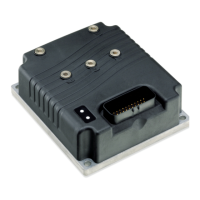Curtis 1222 Manual, os 15
91
2 9 J A N U A R Y 2 0 1 3 D R A F T
bl
Set the Following Error parameters (see page 47)
Setting up the following-error function involves setting three parameters:
Supervision
» Following Error » Error Tolerance (deg), Speed Tolerance (deg/s), and
Error Time.
The parameters
Error Tolerance (deg) and Speed Tolerance (deg/s) are related
through the equation:
Note that
Error Tolerance (deg) is in degrees and Speed Tolerance (deg/s) is in degrees/
second. LS Sensitivity, HS Sensitivity, and Position Kp are all in percent, and should
be entered in decimal form in this equation (e.g., 50% = 0.5). It is recom
-
mended that
Speed Tolerance (deg/s) be set to about half the value given by the
above equation, to allow some safety factor.
If the gear ratio is not known, it may be determined experimentally by
adjusting the Encoder3 Counts/Degree until the Encoder 3 Position (deg) looks close
after multiple revolutions. The gear ratio can then be calculated as:
Speed Tolerance (deg/s) = 0.5 * Error Tolerance (deg) * Min(LS Sensitivity, HS Sensitivity)
*
Position Kp *
Encoder3 Steps
.
Encoder3 Counts/Degree
5 — COMMISSIONING
Likewise, if the gear ratio is known, Encoder3 Counts/Degree may be determined
by the above equation. If we then combine these two equations and include
the suggested safety factor of 1/2, we get:
The Error Tolerance (deg) value should be not too large to accept the steady state
error, and not too small to accept the resulting
Speed Tolerance (deg/s). For example,
an Error Tolerance (deg) of 20° means that no fault will be detected as long as the
Wheel Position (deg) is within ±20° of Steer Command (deg). Thus a steady state error
of 20° is allowed, which is probably too high for most applications. If we choose
instead an
Error Tolerance (deg) of only 2° and calculate the resulting Speed Toler-
ance (deg/s) for some typical settings of Position Kp = 35%, LS Sensitivity = 70%,
HS Sensitivity = 50%, and a gear ratio of 132, we get a Speed Tolerance (deg/s) of
2.9 deg/s. For most applications this is probably too slow for the wheel to be
moving in the right direction without a fault being issued. For most applica
-
tions, an
Error Tolerance (deg) between 5° and 10° works well. Likewise, a Speed
Tolerance (deg/s) of at least 10 deg/s is often needed to be acceptable.
Speed Tolerance (deg/s) ≤ Error Tolerance (deg) * Min(LS Sensitivity, HS Sensitivity) * Position Kp
*
360 RPM
*
360 deg
*
1 Min
*
1
,
1 deg 1 Rev 60 s Gear Ratio
where Gear Ratio =
Motor Revs
.
Wheel Revs
Gear Ratio =
Encoder3 Counts/Degree
*
360 deg
.
Encoder3 Steps * 4 1 Rev

